Hibernate doReturningWork() method Example
In this tutorial, we will learn Hibernate 4 Returning Work interface and Session.doReturningWork() method for Jdbc.
1. Introduction
- Object-Relational Mapping or ORM is the programming technique to map application domain model objects to the relational database tables
- Hibernate is a Java-based ORM tool that provides the framework for mapping application domain objects to the relational database tables and vice versa. It provides the reference implementation of the Java Persistence API that makes it a great choice as an ORM tool with benefits of loose coupling
- A Framework that an option to map plain old Java objects to the traditional database tables with the use of JPA annotations as well as
XMLbased configuration

1.1 Annotations in Hibernate
- Hibernate annotations are the newest way to define mappings without the use of a
XMLfile - Developers use annotations to provide metadata configuration along with the Java code. Thus, making the code easy to understand
- XML provides the ability to change the configuration without building the project. Thus, annotations are less powerful than the
XMLconfiguration and should only be used for table and column mappings - Annotations are preconfigured with sensible default values, which reduce the amount of coding required. For e.g., Class name defaults to Table name and Field names default to Column names
1.2 Work interface in Hibernate 4
In the hibernate framework; developers can easily convert the Session object to Jdbc connection object. Thus, hibernate 4 introduces two new methods in the session interface i.e.
Session.doWork(): For performing the CRUD operationsSession.doReturningWork(): For returning the data from the database
To understand the above concept, let us open the eclipse ide and implement the Session.doReturningWork() method in the hibernate framework! Do note, we are assuming while practicing this code you already have Hibernate and MySql installed on your systems.
2. Hibernate doReturningWork() method Example
Here is a systematic guide for implementing this tutorial.
2.1 Tools Used
We are using Eclipse Kepler SR2, JDK 8, MySQL database and Maven.
2.2 Project Structure
In case you are confused about where you should create the corresponding files or folder, let us review the project structure of the application.
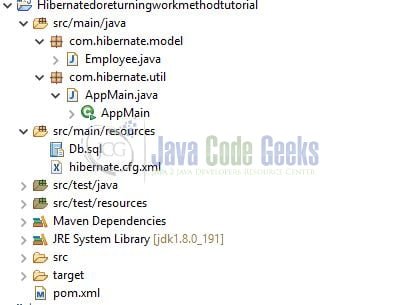
2.3 Project Creation
This section will demonstrate how to create a Java-based Maven project with Eclipse. In Eclipse IDE, go to File -> New -> Maven Project.
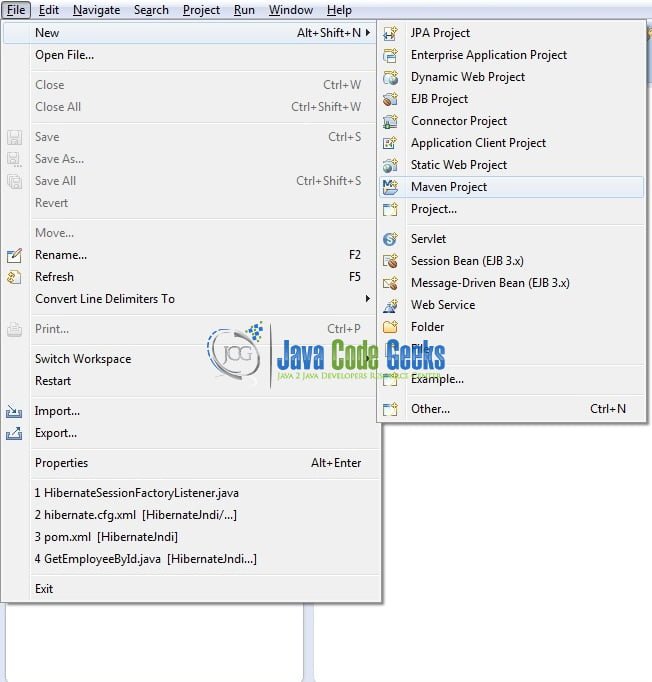
In the New Maven Project window, it will ask you to select the project location. By default, ‘Use default workspace location’ will be selected. Select the ‘Create a simple project (skip archetype selection)’ checkbox and just click on the next button to proceed.
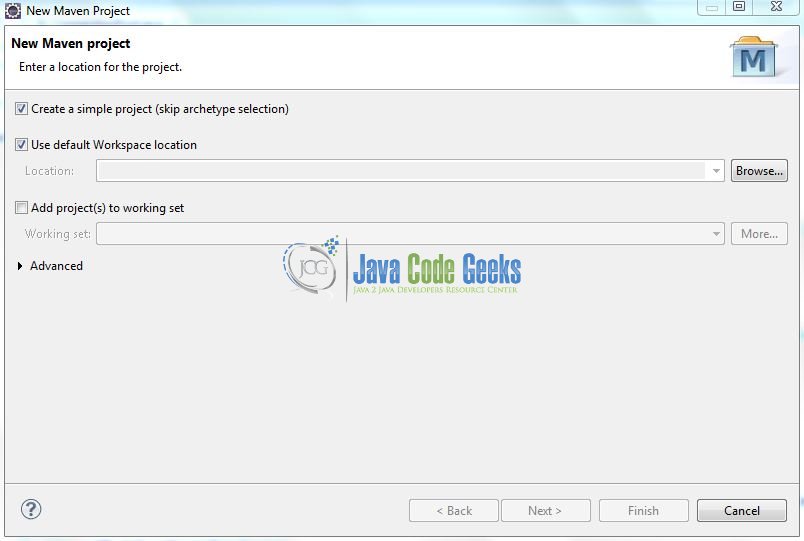
It will ask you to ‘Enter the group and the artifact id for the project’. We will input the details as shown in the below image. The version number will be by default: 0.0.1-SNAPSHOT.
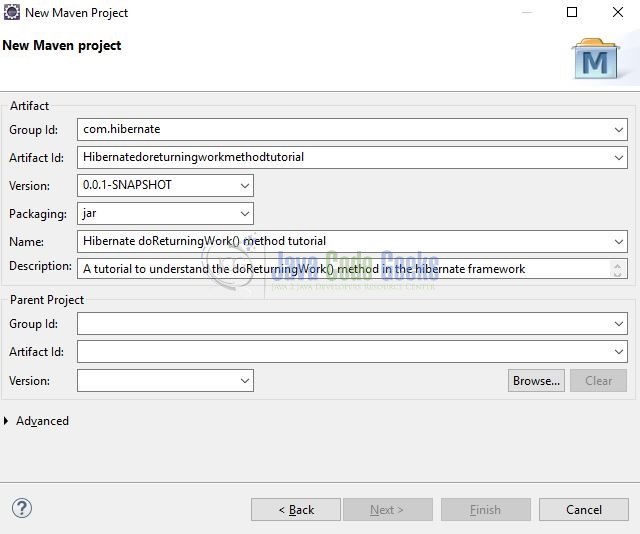
Click on Finish and the creation of a maven project is completed. If you observe, it has downloaded the maven dependencies and a pom.xml file will be created. It will have the following code:
pom.xml
<project xmlns="http://maven.apache.org/POM/4.0.0" xmlns:xsi="http://www.w3.org/2001/XMLSchema-instance" xsi:schemaLocation="http://maven.apache.org/POM/4.0.0 http://maven.apache.org/xsd/maven-4.0.0.xsd"> <modelVersion>4.0.0</modelVersion> <groupId>com.hibernate</groupId> <artifactId>Hibernatedoreturningworkmethodtutorial</artifactId> <version>0.0.1-SNAPSHOT</version> <name>Hibernate stored procedure example</name> <packaging>jar</packaging> </project>
We can start adding the dependencies that developers want like Hibernate, MySQL etc. Let us start building the application!
3. Application Building
Below are the steps involved in developing this application.
3.1 Database and Table Creation
The following script creates a database called ducat with the table employee. Open MySQL terminal or workbench to execute this sql script.
CREATE DATABASE IF NOT EXISTS ducat; USE ducat; CREATE TABLE employee ( eid INT(50) NOT NULL AUTO_INCREMENT, ename VARCHAR(200) DEFAULT NULL, ecompany VARCHAR(200) DEFAULT NULL, edept VARCHAR(100) DEFAULT NULL, egender VARCHAR(100) DEFAULT NULL, PRIMARY KEY (eid) ); insert into employee (eid, ename, ecompany, edept, egender) values (1, 'Jolene Gredden', 'Centizu', 'Research and Development', 'Female'); insert into employee (eid, ename, ecompany, edept, egender) values (2, 'Virgie Madle', 'Tambee', 'Legal', 'Male'); insert into employee (eid, ename, ecompany, edept, egender) values (3, 'Vaughn Sager', 'Jabbercube', 'Product Management', 'Male'); insert into employee (eid, ename, ecompany, edept, egender) values (4, 'Jordan Casajuana', 'Jetwire', 'Services', 'Female'); insert into employee (eid, ename, ecompany, edept, egender) values (5, 'Demetre Rubury', 'Dabfeed', 'Marketing', 'Male'); insert into employee (eid, ename, ecompany, edept, egender) values (6, 'Selinda Hasser', 'Trudeo', 'Accounting', 'Female'); insert into employee (eid, ename, ecompany, edept, egender) values (7, 'Kerwin Michelin', 'Kayveo', 'Research and Development', 'Male'); insert into employee (eid, ename, ecompany, edept, egender) values (8, 'Jarrod Godon', 'Wikibox', 'Training', 'Male'); insert into employee (eid, ename, ecompany, edept, egender) values (9, 'Ernst Goodlip', 'Skyble', 'Services', 'Male'); insert into employee (eid, ename, ecompany, edept, egender) values (10, 'Buddy Messager', 'Skynoodle', 'Business Development', 'Male');
If everything goes well, the table will be created and displayed.
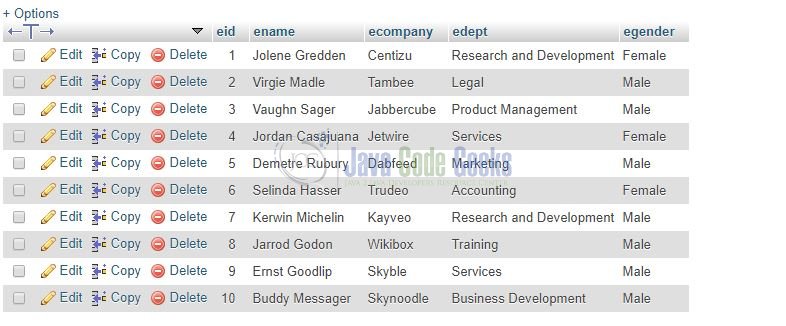
3.2 Stored Procedure Creation
The following script creates a stored procedure to fetch the records from theemployee table.
----- STORED PROCEDURE QUERY TO RETURN THE EMPLOYEE LIST FROM THE DATABASE. DELIMITER $ CREATE PROCEDURE returnEmployeeList() BEGIN SELECT * FROM employee; END $ DELIMITER ;
If everything goes well, the stored procedure will be created as shown in Fig. 7.

3.3 Maven Dependencies
Here, we specify the dependencies for the Hibernate framework and the MySQL connector. Maven will automatically resolve the rest dependencies such as Persistence, MySQL etc. The updated file will have the following code:
pom.xml
<project xmlns="http://maven.apache.org/POM/4.0.0"
xmlns:xsi="http://www.w3.org/2001/XMLSchema-instance"
xsi:schemaLocation="http://maven.apache.org/POM/4.0.0 http://maven.apache.org/xsd/maven-4.0.0.xsd">
<modelVersion>4.0.0</modelVersion>
<groupId>com.hibernate</groupId>
<artifactId>Hibernatedoreturningworkmethodtutorial</artifactId>
<version>0.0.1-SNAPSHOT</version>
<name>Hibernate doReturningWork() method tutorial</name>
<description>A tutorial to understand the doReturningWork() method in the hibernate framework</description>
<dependencies>
<!-- https://mvnrepository.com/artifact/org.hibernate/hibernate-core -->
<dependency>
<groupId>org.hibernate</groupId>
<artifactId>hibernate-core</artifactId>
<version>5.4.1.Final</version>
</dependency>
<!-- https://mvnrepository.com/artifact/mysql/mysql-connector-java -->
<dependency>
<groupId>mysql</groupId>
<artifactId>mysql-connector-java</artifactId>
<version>8.0.15</version>
</dependency>
</dependencies>
<build>
<finalName>${project.artifactId}</finalName>
</build>
</project>
3.4 Java Class Creation
Let us write the Java classes involved in this application.
3.4.1 Implementation of Model Class
This class maps the model attributes with the table column names. Add the following code to the model definition to map the attributes with the column names.
Employee.java
package com.hibernate.model;
import javax.persistence.Entity;
import javax.persistence.GeneratedValue;
import javax.persistence.GenerationType;
import javax.persistence.Id;
import javax.persistence.Table;
@Entity
@Table(name= "employee")
public class Employee {
@Id
@GeneratedValue(strategy= GenerationType.IDENTITY)
private int eid;
private String ename;
private String ecompany;
private String edept;
private String egender;
public Employee(int eid, String ename, String ecompany, String edept, String egender) {
this.eid = eid;
this.ename = ename;
this.ecompany = ecompany;
this.edept = edept;
this.egender = egender;
}
public int getEid() {
return eid;
}
public void setEid(int eid) {
this.eid = eid;
}
public String getEname() {
return ename;
}
public void setEname(String ename) {
this.ename = ename;
}
public String getEcompany() {
return ecompany;
}
public void setEcompany(String ecompany) {
this.ecompany = ecompany;
}
public String getEdept() {
return edept;
}
public void setEdept(String edept) {
this.edept = edept;
}
public String getEgender() {
return egender;
}
public void setEgender(String egender) {
this.egender = egender;
}
@Override
public String toString() {
return "Employee [Id=" + eid + ", Name=" + ename + ", Company=" + ecompany + ", Department=" + edept
+ ", Gender=" + egender + "]";
}
}
3.4.2 Implementation of Utility Class
Add the following code to the implementation class for using the doReturningWork() method in the hibernate framework.
AppMain.java
package com.hibernate.util;
import java.sql.CallableStatement;
import java.sql.Connection;
import java.sql.ResultSet;
import java.sql.SQLException;
import java.util.ArrayList;
import java.util.List;
import org.hibernate.Session;
import org.hibernate.cfg.Configuration;
import org.hibernate.jdbc.ReturningWork;
import com.hibernate.model.Employee;
public class AppMain {
public static void main(String[] args) {
// Creating the configuration instance & passing the hibernate configuration file.
Configuration config = new Configuration();
config.configure("hibernate.cfg.xml");
// Hibernate session object to start the db transaction.
Session s = config.buildSessionFactory().openSession();
// Fetching the data from the database using the Hibernate's ReturningWork interface.
// Hibernate's doReturningWork() method performs the SELECT operations in the database!
List<Employee> emp = null;
// Just pass object to ReturningWork<T> interface.
emp = s.doReturningWork(new ReturningWork<List<Employee>>() {
@Override
public List<Employee> execute(Connection connection) throws SQLException {
Employee e = null;
CallableStatement cstmt= null;
List<Employee> inrList = new ArrayList<Employee>();
try {
String sqlString= "{call returnEmployeeList}";
cstmt = connection.prepareCall(sqlString);
ResultSet rs = cstmt.executeQuery();
while(rs.next()) {
e = new Employee(rs.getInt("eid"), rs.getString("ename"), rs.getString("ecompany"), rs.getString("edept"), rs.getString("egender"));
inrList.add(e);
}
} finally {
cstmt.close();
}
return inrList;
}
});
// Displaying the employee records returned from the database table.
if(emp != null && emp.size() > 0) {
for(Employee e : emp) {
System.out.println(e.toString());
}
} else {
System.out.println("No employee record exists in the table.");
}
// Closing the session object.
s.close();
}
}
3.5 Hibernate Configuration File
In the configuration file, we will include the database and the mapping class details.
hibernate.cfg.xml
<?xml version="1.0" encoding="UTF-8"?> <!DOCTYPE hibernate-configuration PUBLIC "-//Hibernate/Hibernate Configuration DTD 3.0//EN" "http://www.hibernate.org/dtd/hibernate-configuration-3.0.dtd"> <hibernate-configuration> <session-factory> <!-- Database connection settings --> <property name="hibernate.connection.driver_class">com.mysql.cj.jdbc.Driver</property> <property name="hibernate.connection.url">jdbc:mysql://localhost:3306/ducat</property> <property name="hibernate.connection.username">root</property> <property name="hibernate.connection.password" /> <!-- Sql dialect --> <property name="hibernate.dialect">org.hibernate.dialect.MySQL5Dialect</property> <!-- Printing the sql queries to the console --> <property name="show_sql">true</property> <!-- Mapping to the create schema DDL --> <property name="hbm2ddl.auto">validate</property> <!-- Model class --> <mapping class="com.hibernate.model.Employee" /> </session-factory> </hibernate-configuration>
Important points:
- Here, we instructed Hibernate to connect to a MySQL database named
ducatand the mapping class to be loaded - We have also instructed the Hibernate framework to use
MySQL5Dialecti.e. Hibernate will optimize the generated SQL statements for MySQL - This configuration will be used to create a hibernate
SessionFactoryobject hbm2ddl.autotag will instruct the hibernate framework to validate the database table schema at the application startupshow_sqltag will instruct the hibernate framework to log all the SQL statements on the console
4. Run the Application
To run the Hibernate application, Right-click on the AppMain class -> Run As -> Java Application. Developers can debug the example and see what happens after every step!
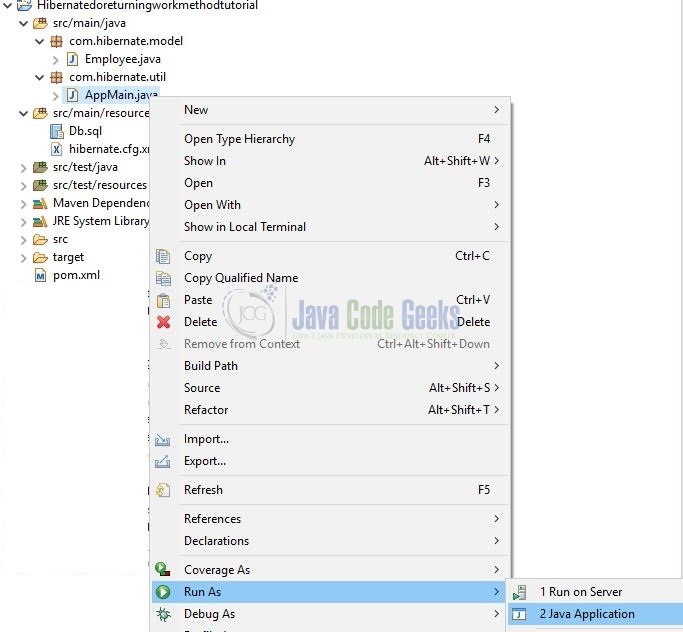
5. Project Demo
Output like below will be displayed in the console.
INFO: HHH000490: Using JtaPlatform implementation: [org.hibernate.engine.transaction.jta.platform.internal.NoJtaPlatform] Employee [Id=1, Name=Jolene Gredden, Company=Centizu, Department=Research and Development, Gender=Female] Employee [Id=2, Name=Virgie Madle, Company=Tambee, Department=Legal, Gender=Male] Employee [Id=3, Name=Vaughn Sager, Company=Jabbercube, Department=Product Management, Gender=Male] Employee [Id=4, Name=Jordan Casajuana, Company=Jetwire, Department=Services, Gender=Female] Employee [Id=5, Name=Demetre Rubury, Company=Dabfeed, Department=Marketing, Gender=Male] Employee [Id=6, Name=Selinda Hasser, Company=Trudeo, Department=Accounting, Gender=Female] Employee [Id=7, Name=Kerwin Michelin, Company=Kayveo, Department=Research and Development, Gender=Male] Employee [Id=8, Name=Jarrod Godon, Company=Wikibox, Department=Training, Gender=Male] Employee [Id=9, Name=Ernst Goodlip, Company=Skyble, Department=Services, Gender=Male] Employee [Id=10, Name=Buddy Messager, Company=Skynoodle, Department=Business Development, Gender=Male]
That is all for this tutorial and I hope the article served you whatever you were looking for. Happy Learning and do not forget to share!
6. Conclusion
This post defines the implementation of the Session.doReturningWork() method in the hibernate framework and helps developers understand the basic configuration required to achieve this. Developers can download the sample application as an Eclipse project in the Downloads section.
7. Download the Eclipse Project
This was an example of using the Session.doReturningWork() method in the Hibernate framework.
You can download the full source code of this example here: Hibernate doReturningWork() method Example



